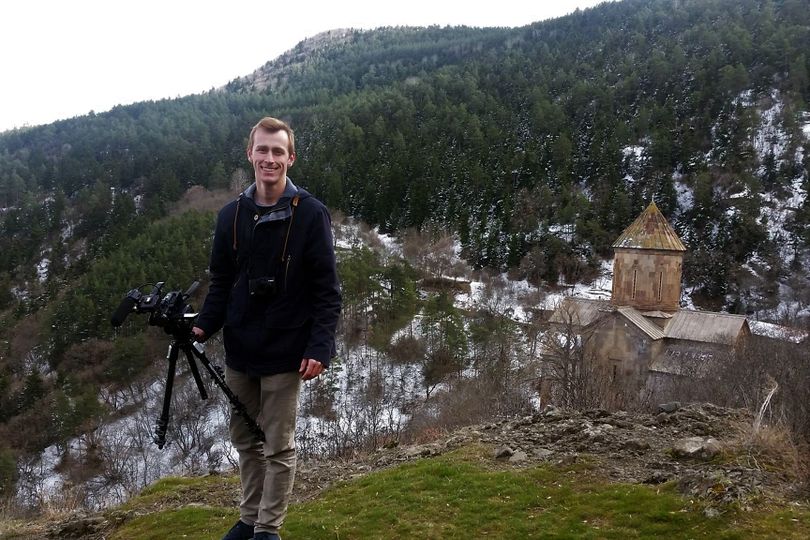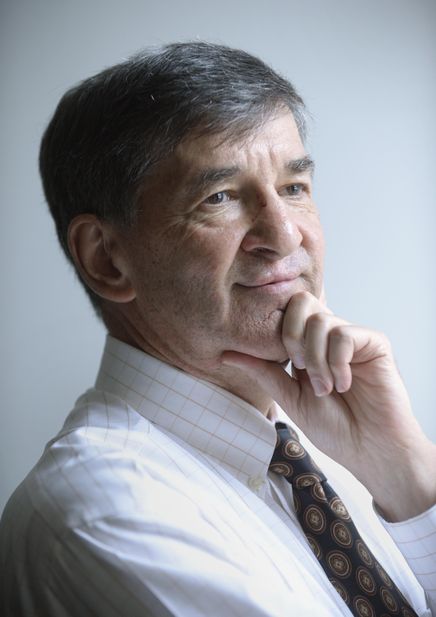Republic of Georgia: what a country

Last month, I hosted a blog post by WSU student Chad Sokol, who spent 10 days in the Republic of Georgia in March. The photo by Dachi Grdzelishvili shows Sokol standing on a ridge of the Caucasus Mountains overlooking Sapara Monastery near Akhaltsikhe, Georgia, on March 16. Here's Sokol's final blog post, which he sent to me last week while I was traveling:
It’s April 11, 2016, nearly three weeks since we returned from Georgia, and I’ve neglected this blog for far too long. I had intended to write a play-by-play of the whole trip, chronicling every sound, sight, smell, checkpoint, mishap and conversation that caught my attention. After those first few jam-packed, jet-lagged days, however, I lacked enough brainpower to write that much — not to mention organize our hundreds of photos and video clips. So, now that I have a moment between classes and other work, here’s the abridged version.
Georgia at times was bewildering. The architecture, for example, raised questions from the moment we arrived in Tbilisi. Just outside the airport, there’s a big golden building with sharp geometric features. It appears to be a train station, but it’s really only a shell; no trains pull through it, and no one works inside. That, as our guide Dachi explained, is one of many shell buildings commissioned by a former president in the mid-2000s to show off Georgia’s economic “prosperity.”
Miles away, the presidential palace sits on a hill overlooking the downtown area. With Greek columns and all the other features one expects of a federal government building, it reminded me vaguely of the White House. The dome, however, stood out; it’s made of hundreds of deep-blue panes of glass, which Dachi said are meant to symbolize government transparency. Perhaps the weirdest structure, though, is the House of Justice, the roof of which looks like a pile of giant, white mushrooms. It too features many windows, for transparency.
All that wonky grandeur stands in stark contrast to the rest of the city, with its mazes of cobblestone streets and centuries-old Orthodox churches. On seemingly every corner, there is a tiny bakery selling traditional Georgian bread, a souvenir shop selling keychains and fridge magnets, or a shop stocked with fine Georgian wine — the country’s most prized export. Many buildings are in disrepair, and beggars line the busy sidewalks.
I hadn’t been born when the Soviet Union collapsed, so it surprised me somewhat to see remnants of the Cold War still permeating daily life. The facade of the old parliament building, for example, once featured a large hammer-and-sickle carving. It was chiseled away when Georgia declared independence, and the rough, round patch of stone remains to this day. One block to the west, the former headquarters of the Georgian KGB now houses the country’s intelligence ministry. And a giant statue of Joseph Stalin once stood a quarter-mile away, in a plaza now called Freedom Square.
Speaking of government and politics, Georgia is about as polarized as the United States. After talking to dozens of politicians, journalists and citizens — many of whom we simply stopped on the street — we noticed a distinct philosophical divide between older and younger generations. Georgians who were my age during the USSR’s heyday liked the guarantee of a stable job, even if the pay was low and the supervisor was corrupt. Younger Georgians, meanwhile, feel a gravitational pull from the West and welcome the rising tide of capitalism. (Tbilisi now has not one but four McDonald’s restaurants, which I’m told is a big deal.)
The Georgian government has tried tirelessly in recent years to join NATO and the European Union, but bank collapses, a refugee crisis and maneuvers by the Kremlin have stunted that effort. At the same time, the country faces substantial challenges on its own turf, notably the Russian-backed separatist regions of Abkhazia and South Ossetia, and a rural eastern region called the Pankisi Gorge, which is known as a haven for Islamic extremism. And Georgian society appears to be in a state of flux; while Orthodox Christianity continues to hold vast conservative influence, technology connects the younger generation with Western-inspired social movements, such as the push for women’s rights.
Georgians — at least the Georgians we met — are incredibly proud to be Georgian. In Akhaltsikhe, for example, we met a winemaker named George, who said he’s invested heavily in local vineyards because he wants to restore a grape-growing culture that disappeared from that corner of the country centuries ago. We also visited Orthodox monks at nearby Sapara Monastery, a secluded complex of churches nestled in the Caucasus Mountains. For men who live in constant isolation, their hospitality came as a shock. You must try the bread, and the wine, and the sweets, they said, because Georgians treat their guests like royalty.
One thing is certain: I learned a lot.
